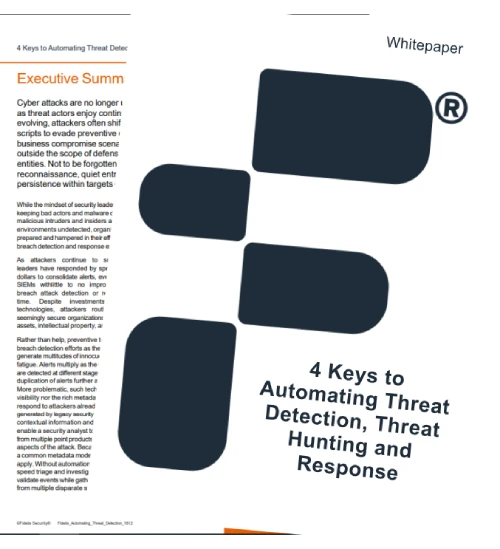Your SOC scrambles when alerts flood in: disparate tools, manual triage, and slow follow-through mean attackers move faster than your defenses.
That gap from detection to containment stretches dwell time, increases breach impact, and drains your team. Manual tasks consume your most valuable resource—analyst attention—while every second matters in incident response.
Extended Detection and Response (XDR) transforms your workflow—from alert to action—into an integrated, automated path. XDR aligns detection, investigation, and containment into a single streamlined pipeline, accelerating real-time threat containment and improving SOC efficiency.
What makes real-time threat containment critical in modern incident response?
1. You reduce dwell time and limit attacker impact
When you delay containment, adversaries recon, exfiltrate data, and embed deeper. XDR lets you define real-time response actions—such as isolating endpoints or blocking network traffic—to neutralize threats immediately. Every second you save directly reduces business risk.
Maturing Advanced Threat Defense
4 Must-Do’s for Advanced Threat Defense
Automating Detection and Response
2. You minimize manual handoffs and execution delays
Traditional IR workflows require analysts to escalate, engage ops teams, and wait for execution. XDR automates these steps. Triggers align detection with containment actions. You stay in control, execution happens without delay, and your SOC stays agile.
3. You take consistent, repeatable action
Without automation, incident response is uneven—some alerts get fast attention, others slip. XDR ensures that high-confidence threats follow the same successful script every time. That consistency improves results and makes your SOC more predictable and resilient.
How does an incident response workflow look when powered by XDR?
1. Detect—integrated signal aggregation
XDR ingests telemetry from endpoints, network, cloud, and identity systems into a unified detection engine. You see threats that cross layers—like a compromised endpoint triggering unusual network behavior—immediately and holistically.
2. Investigate—with context-rich enrichment
Upon detection, XDR enriches alerts with user identity, affected assets, process lineage, and risk scores. You don’t hunt in silos—you get a curated, contextualized view that guides faster decision-making.
3. Contain—automated for speed and precision
The moment a threat is authenticated, XDR executes predefined actions—such as suspending user sessions, quarantining hosts, or applying firewall rules—reducing response time without compromising control.
4. Remediate—guided, actionable next steps
After containment, XDR provides clear remediation workflows: patch guidance, root cause reports, and suggested quarantines. You expedite recovery, reduce errors, and prepare for audits.
What operational efficiencies will XDR bring to your SOC?
1. SOC automation reduces analyst burden
With XDR, analysts spend less time on repetitive tasks. Automated workflows execute routine steps, allowing your team to focus on investigations, adversary behavior, and strategic improvements.
2. Improved incident management visibility
XDR dashboards give you end-to-end visibility—from detection to containment. You track progress, SLA compliance, and backlog directly, improving reporting and operational oversight.
3. Faster threat investigation and remediation
XDR correlates signals and aggregates evidence automatically. You don’t need to pivot between multiple consoles; context comes to you, enabling faster decisions and reducing mean time to remediation (MTTR).
4. Stronger compliance posture with audit trails
All XDR actions are logged: detection triggers, response actions, analyst overrides. You gain forensic-grade audit trails that support breach notification, compliance reporting, and post-incident review.
Why integrate XDR over piling tools for detection and containment?
ChallengeTraditional ResponseXDR-Enabled Workflow
Tool fragmentationSeparate consoles, inconsistent contextUnified platform, correlated signalsManual executionSlow, error-prone, inconsistentAutomated containment with audit trailsAnalyst fatigueFlooded with alerts, tiered triagePrioritized, context-rich detectionOperational visibilityDashboard disconnects across toolsEnd-to-end visibility, SLA tracking
XDR ensures your detection and containment efforts are not just reactive, but orchestrated—and always within control.
How Fidelis Elevate XDR powers streamlined incident response
1. Unified detection across layers
Fidelis Elevate ingests signals from network flows, endpoints, deception sensors, and identity systems. You get real-time detection across your infrastructure, even in hybrid or high-traffic environments.
2. Signal correlation with enriched context
Fidelis Elevate enriches detections with MITRE ATT&CK mappings, affected user and asset risk scores, and behavioral anomalies. You can rapidly assess threat severity and decide on containment confidently.
3. Automated, high-confidence containment actions
For high-fidelity alerts, Elevate automates actions like endpoint isolation, network blocking, or user suspension, aligned with your IR workflows. You reduce end-to-end latency without losing forensic control.
4. Human-in-the-loop with scalable orchestration
When alerts require deeper review, Elevate allows analysts to review flagged evidence, make informed decisions, and trigger orchestration with one click, maintaining oversight while accelerating execution.
What can you achieve in the first 90 days with XDR?
1. Week 1–2: Baseline and unify visibility
Connect endpoints, network logs, cloud accounts, and identity contexts.
Create a baseline of normal activity and prioritize threat vectors.
2. Week 3–6: Build detection and containment playbooks
Define real-time response actions: isolate, re-auth, quarantine.
Map playbooks to detect signals for consistency.
3. Week 7–12: Automate and validate operational performance
Enable auto-containment for confirmed threats, review false positives.
Monitor operational metrics: dwell time, incident volume, containment success rate.
From detection to containment, XDR transforms security operations. Instead of fragmented alerting, slow handoffs, or ad-hoc responses, you gain a unified, automated, and context-rich workflow. Fidelis Elevate XDR delivers that transformation—so you can detect faster, contain earlier, and operate smarter.
Don’t let attackers surprise you. Move from reactive triage to proactive orchestration. Deploy XDR—and take control of your incident response workflows today.
See why security teams trust Fidelis to:
Cut threat detection time by 9x
Simplify security operations
Provide unmatched visibility and control
The post Why Your SOC Needs XDR to Automate Threat Detection and Containment appeared first on Fidelis Security.

No Responses